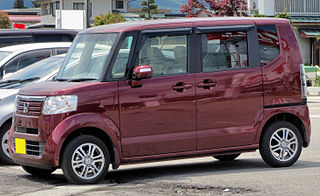
Kei car is the smallest category of Japanese, expressway-legal motor vehicles. 'Kei' is diminutive for kei-jidōsha,, "light automobile" or "compact automobile". With restricted dimensions and engine specifications, owners benefit firstly from lower taxes and insurance rates which lead to a lower overall cost of ownership. And in most rural areas, importantly, they were also exempted from the general Japanese shako shōmeisho (車庫証明書) parking-space ownership requirement to legally buy a motor vehicle at all, as street parking is generally restricted in Japan. Japan's carmakers also make microvans and kei trucks within this legal category.

The Mazda R360 is a kei car manufactured and marketed by Mazda as the company's first passenger car — a two-door, four-seat coupé. Introduced in 1960, the R360 featured a 1,760 mm (69.3 in) wheelbase, weighed 380 kg (838 lb) and was powered by a rear-mounted air-cooled 356 cc V-twin engine producing 16 PS (12 kW) and 22 N⋅m (16 lb⋅ft) of torque. The car was capable of 84 km/h (52 mph) and featured a 4-speed manual or two-speed automatic transmission. The suspension, front and rear, was rubber "springs" and torsion bars.
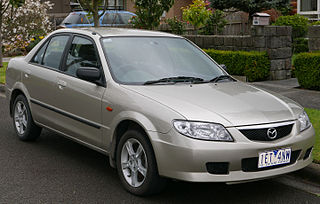
The Mazda Familia, also marketed prominently as the Mazda 323, Mazda Protegé and Mazda Allegro, is a small family car that was manufactured by Mazda between 1963 and 2003. The Familia line was replaced by the Mazda3/Axela for 2004.

The Mazda Bongo, also known as Mazda E-Series and the Ford Econovan, is a cabover van and pickup truck manufactured by the Japanese automobile manufacturer Mazda since 1966. The Bongo name was also used for the Bongo Friendee, which is not a cabover design.
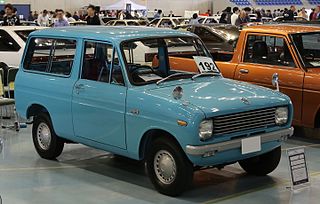
The Mazda Porter and Porter Cab are a series of small kei trucks that were produced from 1961 to 1989 by Mazda, mainly for sale in the domestic Japanese market. Export versions of the Porter were labelled E360. The Porter was replaced by the Autozam Scrum, a rebadged Suzuki Carry.

The Subaru Rex, also known as Ace, Viki, Sherpa, 500/600/700, Mini Jumbo, Mini Subaru or M60/M70/M80 in various export markets, is a kei class automobile produced from 1972 to 1992 mainly for sale in Japan by Subaru, although it was also sold in Europe, South America, Australia and the Caribbean. The Rex superseded the R-2 as Subaru's kei car, and has been available in commercial use versions as well as in a passenger car version. It underwent major changes in 1976, in fall 1981, and again in late 1986. The second generation Rex (1981–1986) also formed the basis for the larger Subaru Justy.
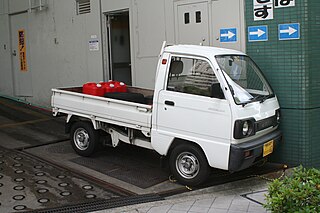
The Autozam Scrum, later known as Mazda Scrum, is a cabover microvan and kei truck sold exclusively in Japan by Japanese automaker Mazda. Originally part of the company's Autozam marque, it was first introduced in June 1989. Mazda still sells the Scrum under its own name. The Scrum is a rebadged version of the Suzuki Carry/Every and used Suzuki engines. The first model year had 550-cc (cm3) Suzuki F5B engines producing 34 PS or 25 kW, or 52 PS or 38 kW with an intercooled turbo; after only nine months, this was replaced by the larger-engined DG/DH51 as the kei car standards were changed that year.
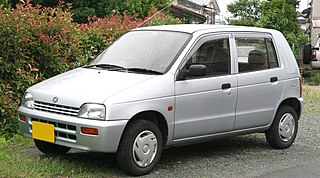
The Suzuki Alto is a kei car produced by Suzuki since 1979. The model, currently in its ninth generation, was first introduced in 1979 and has been built in many countries worldwide. The Alto originated as a commercial vehicle derivative of the Fronte, but over time the Alto nameplate gained in popularity and by 1988 it replaced the Fronte name completely. The Alto badge has often been used on different cars in Japan and in export markets, where it is considered a city car.

The Suzuki Cappuccino is a sports car produced by the Japanese company Suzuki from 1991 to 1998. It is a two-seater roadster with a detachable hardtop that is designed to meet Japanese kei car regulations.

The Daihatsu Fellow Max is a small Japanese automobile in the Kei car class. Originally introduced as the Daihatsu Fellow, the name was partially retained for its successor, the Max Cuore (1977), and then revived in 2000 for the Daihatsu Max.

The Mitsubishi Minica is a model series of kei cars, produced by Mitsubishi Motors Corp. (MMMC) over five generations, from 1962 to 2011, mainly for the Japanese domestic market.

The Suzuki Wagon R is a kei car manufactured and marketed by Suzuki since 1993. The R in the name stands for Revolution and Relaxation. The Wagon R uses a "tall wagon" configuration to maximize cabin space within kei car dimensional restrictions. The Wagon R is also sold by Mazda as the AZ-Wagon from 1994 to 2012 and as the Flair from 2012.
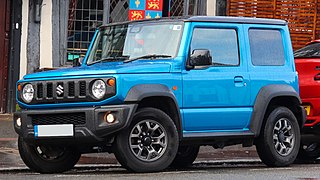
The Suzuki Jimny is a series of four-wheel drive off-road mini SUVs, manufactured and marketed by Japanese automaker Suzuki since 1970.

The Suzuki Fronte is an automobile introduced in March 1962 as a sedan version of the Suzulight Van. The nameplate remained in use for Suzuki's Kei car sedans as well as some commercial-use derivatives until it was replaced by the Alto in September 1988.

The Subaru Sambar is a cabover truck and microvan manufactured and marketed by Subaru as Japan's second truck compliant with the country's strict Keitora (軽トラ) or Kei vehicle tax class, after the Kurogane Baby. Introduced in 1961 in microvan and Kei pickup configurations, the Sambar remains in production, now in its eighth generation — beginning with the sixth generation as a rebadged Daihatsu Hijet.
The Suzuki Cervo is a kei car manufactured by Suzuki Motor Corporation. Introduced in 1976 as the successor to the Suzuki Fronte Coupé, the Cervo name was originally affixed to a kei sports coupe, and then to models derived from the Suzuki Alto. The nameplate was retired between 1998 and 2006, and again in December 2009.

The Suzuki Carry is a kei truck produced by the Japanese automaker Suzuki. The microvan version was originally called the Carry van until 1982 when the passenger van versions were renamed as the Suzuki Every. In Japan, the Carry and Every are kei cars but the Suzuki Every Plus, the bigger version of Every, had a longer bonnet for safety purposes and a larger engine; export market versions and derivatives have been fitted with engines of up to 1.6 liters displacement. They have been sold under myriad different names in several countries, and is the only car to have been offered with Chevrolet as well as Ford badges.
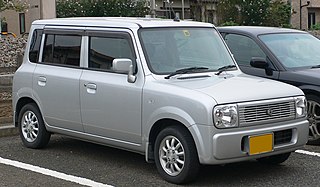
The Suzuki Lapin is a kei car with a five-door hatchback body, manufactured since 2002 by Suzuki for the Japanese market only, and was also marketed in Japan only by Mazda as Mazda Spiano under an OEM agreement through their Autozam stores until 2008. It is based on Suzuki's popular Alto kei car.

The Suzuki F engine is a series of inline three- and four-cylinder internal combustion petrol engines manufactured by Suzuki Motor Corporation and also licensed by many manufacturers for their automobiles. This engine was Suzuki's first four-stroke car engine when it first appeared in 1977.







































